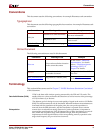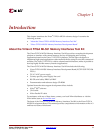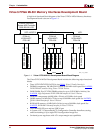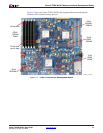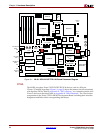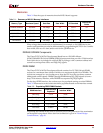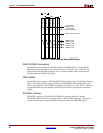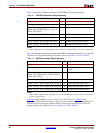
Virtex-5 FPGA ML561 User Guide www.xilinx.com 15
UG199 (v1.2) April 19, 2008
R
Chapter 2
Getting Started
This chapter describes the items needed to configure the Virtex-5 FPGA ML561 Memory
Interfaces Development Board. The Virtex-5 FPGA ML561 Development Board is tested at
the factory after assembly and should be received in working condition. It is set up to load
a bitstream from the CompactFlash card at socket J27 through the System ACE controller
(U45).
This chapter contains the following sections:
• “Documentation and Reference Design CD”
• “Initial Board Check Before Applying Power”
• “Applying Power to the Board”
Documentation and Reference Design CD
The CD included in the Virtex-5 FPGA ML561 Memory Interfaces Tool Kit contains the
design files for the Virtex-5 FPGA ML561 Development Board, including schematics,
board layout, and reference design files. Open the ReadMe.rtf file on the CD to review
the list of contents.
Initial Board Check Before Applying Power
Perform these steps before applying board power:
1. Set up the Configuration Mode jumpers (P27, P46, and P112) for JTAG configuration.
See “Configuration Modes” on page 51 for all available modes for the Virtex-5 FPGA
ML561 Development Board.
2. Confirm that the JTAG chain jumpers P38, P44, and P109 are connecting pins 1 to 2 and
pins 3 to 4. This way, all three devices are in the chain. Otherwise, the ISE iMPACT
software will not find all three devices to configure. For more information see “JTAG
Chain” on page 52.
3. Make sure that no inhibit jumpers are present on any of the power supply regulator
modules. For more information, see “Voltage Regulators” on page 34.
4. The Virtex-5 FPGA ML561 Development Board has a 200 MHz on-board oscillator,
which provides a copy of a differential LVPECL clock to each of the three FPGAs
through a differential clock buffer (ICS853006). There is also a connection to a pair of
SMA connectors (J19, J20) to provide a differential LVDS clock from an off-board signal
generator. Another differential clock buffer (ICS853006) provides a copy of this clock to
each of the three FPGAs. These clocks are available after configuration for the design to
use for various system clocks.





